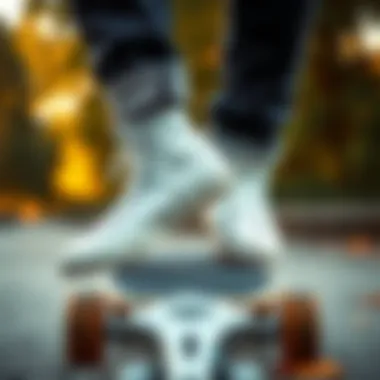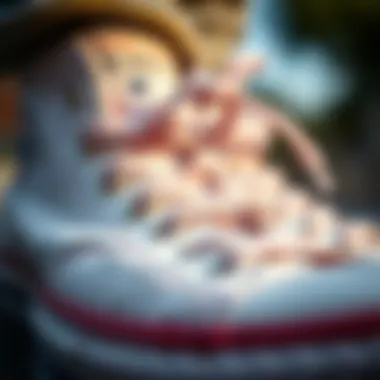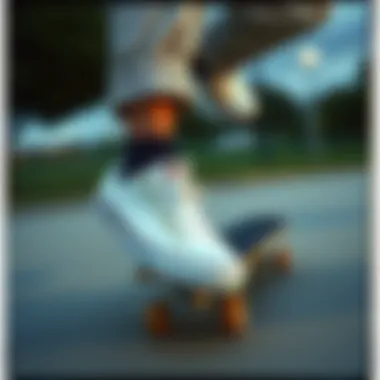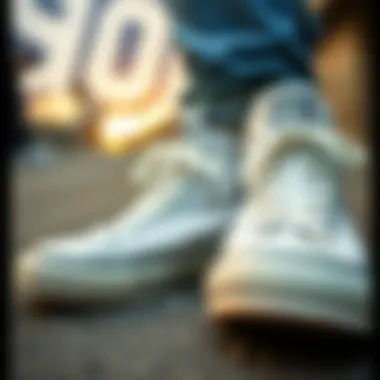The Role of White Chuck Taylors in Skateboarding Culture


Intro
White Chuck Taylors, often simply referred to as "Chucks," have long been more than just footwear. For many skateboarders, they symbolize a lifestyle ethos, blending functionality with aesthetic appeal. Their simple, canvas design initially made them popular on the basketball courts of the 20th century. Yet, it was the skateboarding culture that truly embraced them. As these shoes transitioned into the realm of skateboarding, they carved out a unique niche that condenses historical significance and contemporary relevance.
Skateboarders are a dedicated group, often looking for gear that stands up to the rigors of their sport while also reflecting their personal style. Chucks have managed to remain fashionable, allowing male skaters to express themselves while engaging in tricks and stunts. Their historical roots provide a rich context, connecting the original shoes to today’s vibrant skate scene.
In this article, we will not only explore the design and appeal of white Chuck Taylors but will also dig into practical advice—including maintenance tips and styles to incorporate into a skater's wardrobe. By highlighting these key aspects, we aim to provide an insightful guide that can help skaters, coaches, parents, and educators understand the vital role these shoes play in skateboarding culture.
The History of White Chucks in Skateboarding
The history of white Chuck Taylor shoes is not just a tale about footwear; it's interwoven with the very fabric of skateboarding culture. Understanding their significance provides insights into the evolution of skating styles, community identities, and the triumph of personal expression through fashion. As a staple among skaters, the journey of the Chuck Taylor withstands the test of time, illustrating how a simple shoe grew to symbolize rebellion, creativity, and community spirit in the world of skating.
Origins of the Chuck Taylor All Star
The tale starts in the early 20th century with the Converse Company, which introduced the Chuck Taylor All Star in 1917. Developed as a basketball shoe, its functionality quickly won over athletes. However, it wasn't until Charles
The Design Attributes of White Chucks
The design attributes of White Chucks play a pivotal role in their popularity amongst skateboarders. These sneakers are more than just footwear; they're an essential part of the skater's identity. Understanding the various elements that contribute to their effectiveness and appeal can enhance both performance and style.
Materials and Construction
When we talk about White Chucks, the materials used in their construction are worth highlighting. Typically, they are made from a strong canvas, which not only contributes to their lightweight nature but also gives them a certain durability. The rubber outsole is another feature that adds to the overall strength of the shoe. This combination allows for flexibility and resilience, essential for executing tricks on a skateboard.
The simple design of these shoes often belies the sophisticated construction that goes into making them. For instance, the stitching is usually reinforced in critical areas, which is crucial because skateboarders tend to put their shoes through intense wear and tear. Whether it’s kickflips or grinds, the construction of White Chucks ensures they remain intact longer than many might expect.
Colorway and Aesthetic Appeal
White Chucks stand out not just for their function but also for their aesthetic. The clean, timeless white colorway lends itself well to customization; skateboarders often add their flair through artwork or scuffs gained from daily use. This aspect of personalization is what makes them feel more like an extension of the skater rather than just another shoe.
In skate culture, the visual appeal of skate shoes is as vital as their performance attributes. White Chucks can be paired with a vast array of outfits—from a casual tee and ripped jeans to a more polished look with a button-up and chinos. This versatility is a significant reason why they remain a staple in many wardrobes.
Comfort Over Time
The issue of comfort in skateboarding shoes cannot be overstated, and this is where White Chucks have a lot to offer. While they may not have the cushioned insoles found in some modern skate shoes, many skaters enjoy breaking them in to find that perfect fit. The canvas upper molds to the foot over time, creating a comfortable, glove-like feel.
Additionally, as the shoe ages, it tends to develop a unique character, often embodying the experiences of the wearer. This aging process is a point of pride for many skateboarders. The shoes may become somewhat tattered, but this only adds to their charm.
Evaluating the Performance of White Chucks for Skateboarding
Understanding the performance of white Chuck Taylors in skateboarding is crucial for anyone involved in the sport. Skateboarding is not just about tricks and techniques; it's also deeply tied to the equipment used. White Chucks have carved their niche due to several attributes that promise both functionality and style. To ensure that skaters can not only look good but also perform at their best, several performance aspects must be considered.
Traction and Grip Features
One of the most critical factors when it comes to skateboarding shoes is the grip they provide. White Chucks are often lauded for their rubber outsole which features a herringbone tread pattern, designed to offer a decent amount of traction.
- Grip on Various Surfaces: While this grip can serve well on flat surfaces, some skaters have noted that it might not hold up well during tricks that involve harder surfaces, such as ramps or rails.
- Slider Techniques: For skaters who engage in slide techniques, the waxy texture of the sole allows for a controlled glide, which can enhance performance during footwork tricks.
Ultimately, while the grip on white Chucks is functional, the real-world performance can vary from skater to skater, depending on the type of skating they favor.
Support and Ankle Stability
Support is another consideration that cannot be overlooked. Generally, white Chuck Taylors have a low-cut design which allows for free ankle movement. For many, this freedom is a double-edged sword:
- Range of Motion: Skaters appreciate the unrestricted movement that low-top Chucks provide, especially for tricks requiring a lot of footwork. However, some might find this to lack the support crucial for larger jumps and landings.
- Personal Preference: This comes down to personal style and preferences. Some skaters, like those who favor street skating, might prioritize maneuverability over escalated ankle support. In contrast, others doing vert skating may look for something higher up the ankle to mitigate injuries.


Durability Under Skating Conditions
Durability is always at the forefront of performance evaluation. Skating can be tough on footwear, and it’s important to know how well white Chucks can stand the test of time. White Chucks typically feature:
- Lightweight Canvas Material: Although this contributes to their comfort, it may sacrifice durability. The canvas tends to wear down more quickly than leather, meaning frequent skaters may have to replace their shoes more often.
- Reinforced Toe Cap: One redeeming feature of white Chucks is the reinforced toe cap, which can withstand significant scuffs that come from tricks like ollies and kickflips. However, skaters need to be aware that the vulnerability of the material to tearing is still a factor to consider.
"Choosing the right footwear is like picking your battles; sometimes it’s not about intensity but about knowing your terrain and equipment."
Whether they lead to a gnarly slide or a perfect landing, understanding these elements can make all the difference in the park or on the streets.
Choosing the Right Size and Fit
Selecting the right size and fit of white Chuck Taylors is more than just a matter of comfort; it can hugely influence a skateboarder’s performance and overall experience. The distinctive vibe of Chucks, paired with the demands of skateboarding, necessitates a precise fit. A too-tight or overly loose shoe can not only dampen a rider’s confidence but also increase the risk of injuries. Thus, understanding sizing intricacies is crucial for both seasoned skaters and newcomers.
Understanding Chuck Taylor Sizing
Chuck Taylors come in a wide range of sizes, and grasping this sizing system is vital. Generally, they follow standard U.S. shoe sizes but can vary significantly in width and fit. For instance, broader feet might find regular sizing a bit constricting. It is common to hear skaters say, "You gotta try 'em on to know," highlighting that just glancing at the label won’t cut it.
- Men's Sizes: Typically start around size 6 and go up to size 14 or more.
- Women’s Sizes: Often run about 1.5 sizes smaller than the men’s equivalent.
- Width Options: Most styles come in standard widths, but some models offer wider options for those needing a plusher fit.
A deeper dive into sizing specifics can save one from bad purchases, especially for those who participate in intense skating sessions. With a snug fit, skaters can better manage their board underfoot, enhancing responsiveness during tricks or jumps.
Tips for Finding the Perfect Fit
Finding that “just right” fit may seem daunting, but it doesn’t have to be. Here are some practical tips to help ensure your Chucks feel like a second skin:
- Measure Your Feet: Take time to measure both feet, as they can differ. Start from heel to toe and try to do this at the end of the day when your feet are most swollen.
- Try Multiple Sizes: Given the variability, trying on different sizes within the same style is essential. A size 10 in one model might feel entirely different in another.
- Wear Proper Socks: Aim to wear the socks you’ll use during skates. This helps in assessing how the shoe will fit during an actual session.
- Check the Fit Around the Heel: Ensure there's minimal heel slip when walking. A secure heel leads to better stability on the board.
- Stand and Flex: When trying them on, stand and flex your foot as if you were skating. Make sure there’s enough room at the toe without excessive movement.
These considerations can help eliminate guesswork in the hunt for ideal footwear. Remember, a comfortable skate can lead to longer sessions and better tricks.
Trying Them On in Practical Settings
To guarantee that your new Chucks will perform well on the board, trying them on in practical settings before purchase is wise. Here’s why:
"What feels comfortable in the store may not cut it on the pavement."
- Skate Shops: Visiting specialized skate shops can make a big difference. They often have testing areas set up, allowing you to get a feel for the shoes while on a board.
- Replicate Movement: Mimic basic skating movements, such as pushing, balancing, and shifting your weight. If possible, take a few short rides on a skateboard in-store to evaluate comfort levels.
- Note the Break-in Period: Keep in mind that Chucks often require some break-in time. An initial fit might feel snug but could loosen slightly with wear, so factor that into your choice.
Incorporating these strategies will not only refine your search for the perfect pair but also heighten your chances of finding a fitting companion on your skateboarding journey.
For additional information regarding sizing and fitting, you can visit Chucks on Wikipedia.
Maintenance and Care for White Chucks
Maintenance and care are crucial when it comes to getting the most out of your white Chuck Taylors. These shoes, though stylish, can quickly lose their appeal if neglected. Proper care not only extends their lifespan but also ensures they look fresh on and off the board. Let's dive into the specifics that can help keep these classics in top form.
Cleaning Techniques for Optimal Appearance
Cleaning your white Chucks is the foundation of good upkeep. Regular cleaning prevents dirt and grime from building up, helping maintain their crisp look.
- Spot Clean Regularly: When you notice a stain, use a damp cloth and mild detergent to address it quickly. This prevents stains from setting in.
- Machine Wash Cautiously: For a thorough cleaning, place your Chucks in a pillowcase and wash them on a gentle cycle with cold water. Avoid fabric softeners as they can affect the material.
- Air Dry Only: Never toss them in the dryer. Air drying preserves the shape and prevents any heat damage.
These techniques maintain not just appearance but also the integrity of the materials used in the shoe's construction.
Preventing and Treating Scuffs


Scuff marks can be an ongoing battle, especially for skateboarders who frequently encounter rough surfaces. Addressing them promptly is essential.
- Prevention is Key: Consider applying a protective scuff guard to the toe box before you head out. This acts as a barrier against typical wear.
- Instant Treatment: For fresh scuffs, a simple eraser or a soft cloth dampened with a little water can often lift them off. Avoid abrasive materials that can scratch.
- Use White Toothpaste: For stubborn marks, dab some non-gel white toothpaste on a cloth and gently rub the area. Rinse with a damp cloth afterward.
By being proactive about scuffs, you can keep your Chucks looking sharp and ready for action.
Storage Tips To Preserve Longevity
Where and how you store your white Chucks can significantly affect their longevity. Good storage practices keep them fresh and reduce unnecessary wear and tear.
- Keep Them Dry: Store them in a cool, dry place away from direct sunlight to avoid yellowing and drying out the material.
- Use Shoe Trees: Inserting shoe trees or stuffing them with newspaper helps maintain their shape while stored, preventing creasing.
- Air Them Out: Avoid sealing them in a box for long periods. Letting them breathe prevents mildew and unpleasant smells.
Following these simple rules can extend the life of your shoes, making sure they look great and feel comfortable for a long time.
Good maintenance of your Chuck Taylors is like good practice in skating: it pays off in the long run.
Styling White Chucks in Skate Culture
White Chuck Taylor shoes have become synonymous with skateboarding culture. This iconic footwear not only offers functionality but also serves as a significant part of a skater's self-expression. Understanding the styling aspects of White Chucks allows skateboarders to blend comfort and aesthetics seamlessly, reflecting their individuality while staying true to skate culture.
Casual Streetwear Combinations
When it comes to casual streetwear, White Chucks are incredibly versatile. They can be paired effortlessly with different types of attire. Many skaters opt for loose-fitting jeans or cargo pants, which provide both mobility and a laid-back vibe. A classic tee or a hoodie can complete the look; the simplicity of the shoes beautifully contrasts with the busy graphics often found on skatewear.
Moreover, layering plays a key role here. A short-sleeved flannel shirt over a plain tee can add depth to the outfit while keeping it functional. Some prefer joggers, which also work well with White Chucks, giving a sporty edge while being perfect for on-and-off board wear.
For a more polished street look, consider adding a denim jacket or a bomber jacket. This combo not only enhances the overall style but can be easily adapted for various weather conditions. Don’t forget to customize with patches or pins that showcase personal interests, keeping the spirit of skate culture lively.
Layering Techniques for Skating Outfits
Layering clothing is not only a practical choice for skaters but also a stylistic one. When combining White Chucks with layers, the goal is to maintain both comfort and style. A base layer, like a fitted tee, paired with an overshirt creates an appealing silhouette. This style ensures that when you hit the skate park, you won’t be hindered by heavy clothing.
Choose fabrics that breathe well. Skateboarding can get hot, so materials that wick moisture are preferred. For colder days, a lightweight jacket worn over a long-sleeve shirt can keep a skater warm without adding bulk. It is important to consider how the jacket fits over your skate gear. Baggy jackets can restrict movement, while fitted jackets allow for greater flexibility on the board.
Accessories such as beanies or caps are great additions to layers. They not only provide warmth but also enhance the overall skate look. Additionally, rolling up the sleeves of your outer layers can offer a more relaxed style while showcasing your wrist accessories like bracelets or watches that resonate with skate culture.
Incorporating Accessories with White Chucks
Accessories can make or break your skateboarding outfit, and White Chucks are a blank canvas for creativity. Consider the following elements to elevate your style:
- Socks: Wearing colorful or patterned socks that poke out from the top of the Chuck Taylors can add a unique flavor to your outfit. Look for designs that showcase your personality.
- Bags: A well-chosen backpack is not only practical but also adds to your style. Brands that cater to skaters often include special compartments for boards, which combines functionality with aesthetics.
- Jewelry: Simple jewelry can subtly enhance a casual look. Consider wearing silver or leather bracelets that speak to your skater vibe. Avoid anything overly flashy, as the focus should remain on the practicality and comfort of the outfit.
- Headwear: Baseball caps or beanies can provide a laid-back touch while also serving practical purposes. They help keep sweat at bay during a skating session.
Incorporating these accessories should feel natural and not forced. The idea is to stay comfortable and true to your own home style, echoing the ethos of skateboarding culture—innovation through individuality.
"Skateboarding isn’t just about the tricks. It’s a form of self-expression through style, and each piece says something about who you are."
By marrying White Chucks with thoughtful styling choices, skaters can ensure their look is as versatile as their skating ability.
Community Perspectives on White Chucks
Exploring community perspectives on white Chucks reveals a rich tapestry woven from personal experiences, cultural significance, and shared identities among skateboarders. These shoes aren’t just a fashion choice; they’re a symbol of belonging." A skatepark's atmosphere can change overnight based on the flavor of sneakers that slide across its pavement. For many skaters, White Chucks represent much more than footwear; they're a cultural emblem.
Personal Stories from Skaters
Many skaters have a tale to tell when it comes to their white Chuck Taylors. Take, for instance, Leo, who remembers the first pair he bought at a small thrift store back in his hometown. He recalls, "They were dirty, but I loved them. Nothing else felt right to me after that day. A pair of shoes can hold memories, you know?" Such stories mirror the sentiments of countless others who started skating not just because of the sport itself, but because of how a simple pair of Chucks made them feel connected to a larger community. Whether it's the first kickflip landed in those shoes or a brutal fall that left scuff marks, these narratives are deeply intertwined with the act of skating itself.


Interviews with Skateboard Influencers
Insights from prominent skateboard influencers provide valuable perspectives on the continued relevance of white Chucks in today's skate scene. Influencer Maria Garcia, known for her vibrant content on platforms like Instagram and YouTube, explains, "White Chucks are a canvas for creativity. Skaters customize them, paint on them, and make them their own. It's all about self-expression." Such insights highlight how these shoes have become a blank slate for many, allowing the skater to project their personality into the sport through uniquely styled Chucks.
Additionally, many influencers bring attention to the balance between style and functionality. Jordan, a professional skater, notes, "You can't skate well if you can't feel the board; Chucks give me that connection right to the ground. Fashion is secondary for me." His comments underscore the importance of performance alongside street cred.
Cultural Significance Within the Skateboarding Community
White Chucks have carved out a sizable niche in skate culture, symbolizing rebellion and individualism. As they become seen in magazines and social feeds, the shoes cultivate a sense of shared identity among skaters across the globe. There's a feeling of kinship evoked — when one sees someone else rocking a pair of Chucks, there's an unspoken acknowledgment.
Skate culture encourages non-conformity, and white Chucks, with their classic design and adaptability, serve a dual purpose: they are both a practical choice and a bold fashion statement. They are often spotted in both urban skateparks and professional competitions, asserting their versatility.
“In a world filled with trends, there’s beauty in consistency,” says skate historian Carl Thompson.
With their deep-rooted presence, Chucks remind us of skateboarding's spirit. They’re not merely shoes but a vernacular through which skaters communicate their love for the sport and the culture it encompasses.
Thus, when delving into the community perspectives on white Chucks, one finds a blend of personal stories, professional insights, and the cultural implications that hold these iconic shoes firmly in the skateboarding landscape.
Environmental Considerations in Chuck Taylor Production
The conversation about Chuck Taylor All Stars stretches beyond just their role in skateboarding aesthetics; it touches on broader environmental concerns. As skate culture grows, so does the urgency for brands like Converse to address their manufacturing practices. The commitment to sustainability influences not only the production of these shoes but also increasingly shapes consumer preferences and the culture surrounding skateboarding.
Sustainable Materials in Manufacturing
When you think about the materials used in a pair of Chuck Taylors, it’s vital to consider their environmental impact. Sustainable materials can come from various sources, emphasizing reduction in environmental harm during the manufacturing process. For example, the use of organic cotton and recycled rubber has become more prevalent in the production of these iconic kicks. Organic cotton is grown without harmful pesticides, while recycled rubber can significantly diminish waste in landfills.
Additionally, brands are also looking to source materials from renewable resources. As skaters become more aware of environmental issues, the desire for shoes made from sustainable materials is rising. This shift not only makes skaters feel good about their purchase but also indirectly pushes the brand to prioritize eco-friendliness in their future designs.
The Brand’s Commitment to Eco-Friendliness
Converse's initiatives to introduce eco-friendly practices into their production lines reflect a growing trend in the apparel industry. The brand has created collections that showcase their adherence to sustainability. For instance, the Chuck Taylor All Star Eco collection is made from materials that lessen the impact on the planet. These movements highlight their commitment to reducing carbon footprints and promoting greener alternatives within their product lines.
"Brands increasingly recognize that being eco-conscious resonates with consumers, influencing buyer decisions in ongoing discussions about sustainability."
Moreover, partnerships with organizations dedicated to environmental causes signal the brand's intention to contribute positively. This not only enhances their public image but also fosters trust and loyalty among skaters who value sustainability. By adopting eco-friendly practices, brands like Converse not only preserve their heritage but also secure a spot in the future currency of skate culture.
Impact on Skateboarding Culture and Consumer Choices
The impact of sustainability on the skateboarding community is becoming increasingly pronounced. As awareness grows about our planet's plight, the preferences of consumers strongly lean towards brands that demonstrate responsibility. Skaters prefer to support labels that engage with sustainable practices, which, in turn, can create a ripple effect throughout the industry.
There are conversations happening within local skate communities about the importance of eco-conscious choices, whether that be shoes or skateboards. This dialogue often leads to increased awareness about ethical brands and materials used in skateboarding gear. In addition, companies that prioritize sustainability may set trends for skate fashion, creating a new standard for what is socially acceptable within the skate community.
Ultimately, as more skaters become informed consumers, this could guide the direction of the industry, ensuring that the next generation of skateboarders have not just a style icon in their wardrobe, but a choice that reflects their values. By fostering a culture that places emphasis on environmental care, we can enjoy the thrill of skating while also nurturing our planet.
The Future of White Chucks in the Skateboarding Scene
The role of white Chuck Taylors in skateboarding is not just a relic of the past, but a dynamic part of its future. This footwear has cemented its reputation through decades of skateboard culture, and the conversation surrounding its evolution is more necessary than ever. The allure of these shoes goes beyond their classic aesthetic; they symbolize a connection to both tradition and modernity as the sport progresses. Understanding the future of White Chucks provides insights into design innovation, fashion trends, and how consumer preferences will shape the landscape of skateboarding.
Potential Design Innovations
The Chuck Taylor silhouette is iconic, but to stay relevant, it must adapt. Future designs may integrate advanced materials that focus on breathability and flexibility while still maintaining that distinct canvas look. Imagine a Chuck Taylor infused with moisture-wicking properties and padded insoles designed to improve comfort during extended skating sessions.
This kind of innovation is not far-fetched. Brands are already experimenting with eco-friendly materials and manufacturing methods. Shifting towards sustainable production could not only lighten the footprint but also appeal to a growing demographic of conscious consumers. Further, imagine unique colorways and limited-edition collaborations that resonate with current cultural movements—something specific to local skate communities or even global art initiatives—tapping into the personal stories skaters want to share.
Evolving Trends in Skate Fashion
As skate culture continues to diversify, so too does the fashion that accompanies it. White Chucks are no longer simply about utility; they’re becoming a canvas for expression. The rise of streetwear has seen their style evolve from functional to fashion-forward. Pairing them with wider-legged pants, oversized t-shirts, or custom graphics creates a striking visual narrative.
Moving forward, we might see more blended styles that incorporate vintage aesthetics with contemporary youth culture. Think about a fusion of retro skateboarding styles paired with modern street influences, extending to accessories like graphic socks and bucket hats, turning a skateboarding outfit into an art form. The past few years have seen a shift in how skaters present themselves, and the future will likely see cross-pollination from different fashion realms, bridging gaps between skateboarders, artists, and even musicians.
Anticipating Customer Preferences
The discerning skater possesses a complex relationship with their gear; they're not just consumers but aficionados. Personal preference will undeniably dictate how the future of White Chucks shapes up. Skaters are likely to seek authentic, individualistic designs that speak to their personal stories and skate identities. Special edition releases based on skaters' input or limited runs that celebrate local skate havens could gain traction.
Furthermore, the push towards community involvement in design decisions may revolutionize how these shoes are marketed. By integrating user-generated feedback and insights, companies can foster a connection with their consumer base that feels genuine. Collaborative projects, perhaps involving local shops or popular skate influencers, can help to make customers feel like they're part of a larger process rather than simply patrons of a brand.







